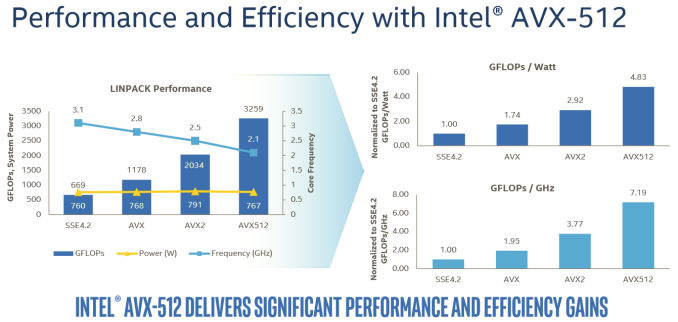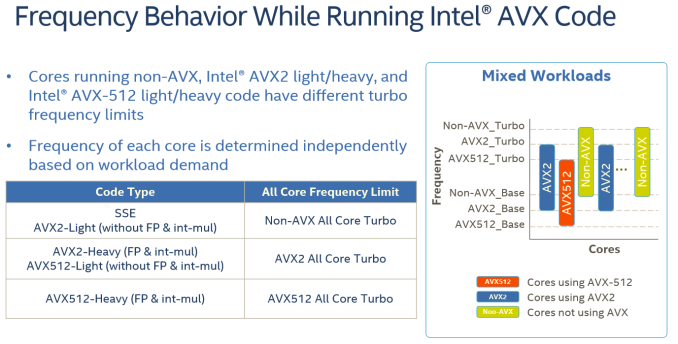Sizing Up Servers: Intel's Skylake-SP Xeon versus AMD's EPYC 7000 - The Server CPU Battle of the Decade?
by Johan De Gelas & Ian Cutress on July 11, 2017 12:15 PM EST- Posted in
- CPUs
- AMD
- Intel
- Xeon
- Enterprise
- Skylake
- Zen
- Naples
- Skylake-SP
- EPYC
Introducing Skylake-SP: The Xeon Scalable Processor Family
The biggest news hitting the streets today comes from the Intel camp, where the company is launching their Skylake-SP based Xeon Scalable Processor family. As you have read in Ian's Skylake-X review, the new Skylake-SP core has been rather significantly altered and improved compared to it's little brother, the original Skylake-S. Three improvements are the most striking: Intel added 768 KB of per-core L2-cache, changed the way the L3-cache works while significantly shrinking its size, and added a second full-blown 512 bit AVX-512 unit.
On the defensive and not afraid to speak their mind about the competition, Intel likes to emphasize that AMD's Zen core has only two 128-bit FMACs, while Intel's Skylake-SP has two 256-bit FMACs and one 512-bit FMAC. The latter is only useable with AVX-512. On paper at least, it would look like AMD is at a massive disadvantage, as each 256-bit AVX 2.0 instruction can process twice as much data compared to AMD's 128-bit units. Once you use AVX-512 bit, Intel can potentially offer 32 Double Precision floating operations, or 4 times AMD's peak.
The reality, on the other hand, is that the complexity and novelty of the new AVX-512 ISA means that it will take a long time before most software will adopt it. The best results will be achieved on expensive HPC software. In that case, the vendor (like Ansys) will ask Intel engineers to do the heavy lifting: the software will get good AVX-512 support by the expensive process of manual optimization. Meanwhile, any software that heavily relies on Intel's well-optimized math kernel libraries should also see significant gains, as can be seen in the Linpack benchmark.
In this case, Intel is reporting 60% better performance with AVX-512 versus 256-bit AVX2.
For the rest of us mere mortals, it will take a while before compilers will be capable of producing AVX-512 code that is actually faster than the current AVX binaries. And when they do, the result will be probably be limited, as compilers still have trouble vectorizing code from scratch. Meanwhile it is important to note that even in the best-case scenario, some of the performance advantage will be negated by the significantly lower clock speeds (base and turbo) that Intel's AVX-512 units run at due to the sheer power demands of pushing so many FLOPS.
For example, the Xeon 8176 in this test can boost to 2.8 GHz when all cores are active. With AVX 2.0 this is reduced to 2.4 GHz (-14%), with AVX-512, the clock tumbles down to 1.9 GHz (another 20% lower). Assuming you can fill the full width of the AVX unit, each step still sees a significant performance improvement, but AVX2 to AVX-512 won't offer a full 2x performance improvement even with ideal code.
Lastly, about half of the major floating point intensive applications can be accelerated by GPUs. And many FP applications are (somewhat) limited by memory bandwidth. While those will still benefit from better AVX code, they will show diminishing returns as you move from 256-bit AVX to 512-bit AVX. So most FP applications will not achieve the kinds of gains we saw in the well-optimized Linpack binaries.













219 Comments
View All Comments
twtech - Thursday, July 20, 2017 - link
I'd really like to see some compile-time benchmarks for these CPUs.For my own particular interests, time taken to do a full recompile of the Unreal 4 engine from source would be very useful. But even something more generic like the Linux kernel compiles per hour benchmark could serve as a useful point of reference.
szupek - Friday, July 21, 2017 - link
Meanwhile, the entire world still runs on IBM's DB2 for Datbases and IBM's Z/AS400 Mainframes. The fastest database in the world, by far...oh and the most secure (it's only hackable by standing in front of the console, seriously). Every single credit card transaction. Every single plain ticket. Most medical records and all of wall street. Yup. IBM still owns. So much that most of commenters probably have no idea just how big IBM truly is. If you care about Database speed & security, these processors shouldn't appeal to you.stevefan1999 - Saturday, July 22, 2017 - link
It's impossible for AMD to win completely.Remember kids, public cloud service providers such as Amazon(AWS), Google(GCP) and Joyent would still stick with Intel due to not only the compatibility issues like ecosystem and vendor inconsistency, but also the VM migration and security and module issues, all mentioned in the presentation slides presented by Intel. They are a very serious matter, as they, the public cloud services, are powering the Internet we use everyday, so being stable, consistent and be able to serve a good amount of SLA is vital to the public cloud, we wouldn't expect them to play with the new lad in the hood, the EPYC.
IIRC only the Microsoft(Azure) are using AMD server CPUs partially in some of their datacenters, running various Linux and Windows VMs using Hyper-V, and they have been performing quite well
The cloud services are exploding every year, but with what I've said, I doubt AMD could even kick in the first door at least for 3 to 4 years. This is still a big-win for Intel and what manipulations will Intel do I don't know.
On the other hand, Intel has failed to service the desktop market and they're figuring out how to hold their asses on the Internet infrastructure, never had them know the crusade of EPYC will come this fast.
The server market is quite a big meat, it's a 21 bil market, cool right? But that you will have guaranteed 'server upgrade' every year, is a bigger matter, as those server CPUs are designated to be disposed given the wattage and performance per dollar is lower on the newer CPUs. Those god-damn server operators will keen to replace their CPU (and therefore some serious metal pollution issues). Intel has been exploiting this and gained a big hurdle of money and therefore had their ecosystem grown. This is how Intel defends their platform by vendor lock-in, pathetic.
AMD is now being performance and cost competitive to Intel, but it's still dead in the High Performance Computing campaign unless AMD could provide higher frequencies. Well I have to say I know nothing about HPC, but I remembered the Bulldozer architecture of AMD is actually targeted and marketed for HPC! That's why AMD failed in general-purpose computing market and started the downfall of AMD/Domination of Intel 5 years ago. Even though we know the fate of Bulldozer, but hopefully AMD could still scrap some of the HPC goodies of Bulldozer out and benefits the mankind by accelerating researches such as finding the cures for cancer or solving some precise physics and mathematics.
Well, anyway the cloud, the HPC and the server market are the last resort for Intel and they will definitely hold their last ground. Good luck AMD on crushing the mean and obese Intel!
errorr - Sunday, July 23, 2017 - link
For all the talk about speed and efficiency the problem is about $$$. The sad fact is that what matters most isn't even the price of the cpus which is chump change in the grand scheme of things but how the software licensing costs are determined. Per core or per socket software pricing will matter a lot. The software companies will decide how successful EPYC is. I have a feeling they will be biased slightly toward AMD at the beginning as it is in their interest to foster competition for Intel, or if they are not forward looking enough the end customers might argue that the competition will benefit the SW companies in the long run by continuing to push competition.msroadkill612 - Thursday, July 27, 2017 - link
Whatever, its all pointless if the competition can read your secrets, which is a matter very close to the hearts of the cheque signers.AMD seem to have something very superior to offer in that department.
qweqwe - Tuesday, August 8, 2017 - link
we just did some heavy inhouse hpc-tests with epyc against diff. intel servers.the epyc is the clear winner in terms of performance and power consumption when it
comes to hand-tuned parallel-vector-code examples.
not bad amd !
readonly1 - Friday, October 27, 2017 - link
qweqwe, I totally agree with you. Our inhouse HPC tests get the similar conclusion, after comparing AMD Epyc 7351 (dual socket, 32 cores, 2400Mhz) and Intel SKylake 6154 (dual socket, 36 cores, 3000Mhz). I think AMD clearly wins in the memory bandwidth, which is extremely important for HPC computation.msroadkill612 - Monday, November 13, 2017 - link
7/11/2017 "Microsoft is already deploying AMD's EPYC in their Azure Cloud Datacenters."Interesting. As i have been theorising, a possible reason for the absence of retail epyc is not supply, but demand.
A single sale can soak up production runs.
If so tho, not much sign of big revenues from it yet, but there are other explanations for that. Contra processors for development work e.g.
q.epsilon.p - Sunday, June 10, 2018 - link
power consumption numbers with every benchmark would have been nice, because these parts are server benchmarks, Perf / Watt is one of the primary concerns. And where AMD kinda crush Intel, because it's isn't exactly being honest with it's TDP values nowadays when it comes to Data Centre and HEDT.TDP was traditionally the absolute maximum the CPU would put out as heat, now with a power consumption of 670W I am assuming that the heat being put out by the CPU is more than 165W.